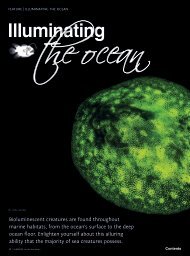Illuminating the ocean_submerge magazine.pdf
- No tags were found...
Create successful ePaper yourself
Turn your PDF publications into a flip-book with our unique Google optimized e-Paper software.
FEATURE | ILLUMINATING THE OCEAN<strong>Illuminating</strong><strong>the</strong> <strong>ocean</strong>By Aida VerdesBioluminescent creatures are found throughoutmarine habitats, from <strong>the</strong> <strong>ocean</strong>’s surface to <strong>the</strong> deep<strong>ocean</strong> floor. Enlighten yourself about this alluringability that <strong>the</strong> majority of sea creatures possess.22 | SUBMERGE Let <strong>the</strong> dive begin
ILLUMINATING THE OCEAN | FEATUREA round stingray illuminated.Image by David Gruber and John Sparks.As a PhD student with research interests in <strong>the</strong>bioluminescence and fluorescence properties of polychaetes(segmented worms), my research aims to clarify <strong>the</strong> biochemicalprinciples of bioluminescence as well as to understand <strong>the</strong>different functions and behavioural implications of lightproduction. As part of my research work, I recently headed toBermuda to witness <strong>the</strong> illuminating mating ritual of fireworms.It is 12 August 2014 and <strong>the</strong> sun has just set over <strong>the</strong> calmblue waters of Bermuda. There was a full moon two nightsbefore and here I am in <strong>the</strong> water, ready for <strong>the</strong> show to begin.Around an hour later, <strong>the</strong> first female fireworm appears, glowingmagically with an intense green light and swimming in circles on<strong>the</strong> <strong>ocean</strong>’s surface. The mating ritual has its desired effect andjust a few seconds later, a male fireworm swims to <strong>the</strong> surface,emitting short flashes of light. In just about 15 minutes, dozensof fireworms leave <strong>the</strong> <strong>ocean</strong> bottom and swim to <strong>the</strong> surface todisplay <strong>the</strong>ir bioluminescent mating dances, turning <strong>the</strong> watersof Ferry Reach Point into a spectacular light show.Bioluminescence is <strong>the</strong> emission of light produced bya chemical reaction. The Bermuda fireworm is a marinepolychaete worm that uses bioluminescence to attract matesfor reproduction. O<strong>the</strong>r members of this family also usebioluminescence in <strong>the</strong>ir mating rituals, which are periodic andsynchronised with <strong>the</strong> moon cycle. Females can glow for up toeight seconds and can repeat <strong>the</strong> process 33 times over a periodof 12 minutes or until <strong>the</strong>y attract a male. Males and femalesga<strong>the</strong>r at <strong>the</strong> surface, swimming in narrow circles and secreting<strong>the</strong>ir gametes for external fertilisation. Odontosyllis worms arejust a few millimetres long, but <strong>the</strong>ir glow is so bright that it iseasily visible from 50m away.These shallow-water polychaete worms are not <strong>the</strong>only marine bioluminescent organisms out <strong>the</strong>re. In fact,bioluminescence is widespread across <strong>the</strong> tree of life, rangingfrom bacteria to vertebrates, and <strong>the</strong> great majority of lightproducingorganisms are marine dwellers. More than 80% of <strong>the</strong>approximately 700 known bioluminescent genera are marineorganisms, and within <strong>the</strong> marine environment, over 90% of<strong>the</strong> biota can produce <strong>the</strong>ir own light. The main reason whyorganisms produce light is not completely understood, butthis feature is closely related with a variety of vital functionssuch as reproduction, feeding, defence and/or communication.In general, longer bioluminescent glows are thought to havean attracting function and short bioluminescent flashes areassociated with repellent signals.Many species of squid use bioluminescent flashes to confuseor startle <strong>the</strong>ir predators, which cause <strong>the</strong>m to hesitate andallows <strong>the</strong> squid enough time to quickly escape. The vampiresquid and o<strong>the</strong>r animals, including copepods, shrimps andctenophores, exhibit variations of this defensive behaviour inwhich <strong>the</strong>y exude or secrete a bioluminescent cloud that actslike a smoke screen, <strong>the</strong>reby making it difficult for <strong>the</strong> predatorto locate <strong>the</strong> escaping prey. Ano<strong>the</strong>r common defensiveAugust/September 2015 SUBMERGE | 23
FEATURE | ILLUMINATING THE OCEANBelow left:An Acanthurid Iarva radiatesa magnificent green light.Image by David Gruber andJohn Sparks.Below right:A fla<strong>the</strong>ad emits red light.Image by David Gruber andJohn Sparks.Bottom left and right:Examples of bioluminescentand fluorescent worms.Images by Aida Verdes.mechanism is <strong>the</strong> use of a sacrificial tag. Organisms like <strong>the</strong> deepseasquid or <strong>the</strong> polynoid worm autotomise luminous body partswhen <strong>the</strong>y encounter a predator. The lost body parts continue tomove and can glow for hours, drawing away <strong>the</strong> attention of <strong>the</strong>predator, while <strong>the</strong> rest of <strong>the</strong> animal escapes in <strong>the</strong> dark.Many marine animals such as crustaceans, cephalopods andfishes also use a defensive technique called counter-illumination.This is a form of camouflage in which <strong>the</strong> animal uses ventrallight-producing organs, called photophores, to match <strong>the</strong> lightcoming from <strong>the</strong> surface and to disguise <strong>the</strong>ir shadow to avoidbeing detected by predators looking upwards.Bioluminescence is also commonly used in predatorybehaviours to lure or search for prey. The most famousbioluminescent predator is probably <strong>the</strong> anglerfish, which hasa light organ where bioluminescent bacteria are cultured. Thefish can control <strong>the</strong> amount of light that is emitted by altering<strong>the</strong> conditions in <strong>the</strong> light organ. Dragonfishes also haveluminous barbels which <strong>the</strong>y use to attract prey, although inthis case, bioluminescence is not produced by bacteria, but by<strong>the</strong> dragonfish itself. A particular type of dragonfish, called <strong>the</strong>loosejaw dragonfish, has special photophores that are able toemit red light, which represents a great advantage since mostmarine organisms can only see blue light. When loosejaws lookfor <strong>the</strong>ir prey, mostly copepods, <strong>the</strong>y can see but cannot be seen.The cookiecutter shark seems to use bioluminescence tocombine both counter-illumination and prey-attraction in itspredatory behaviour. This small shark feeds by taking bites out of<strong>the</strong> flesh of larger fishes, squids and cetaceans. It is hypo<strong>the</strong>sisedthat <strong>the</strong> cookiecutter shark uses counter-illumination to emulate<strong>the</strong> silhouette of <strong>the</strong>se larger species’ prey and attract <strong>the</strong>m closeenough to be able to bite <strong>the</strong>m.Whe<strong>the</strong>r for defence, predation or communication,bioluminescence is widespread and very common in <strong>the</strong> marineenvironment. From <strong>the</strong> shallow depths of Bermuda to <strong>the</strong>deepest depths of <strong>the</strong> <strong>ocean</strong> floor, <strong>the</strong> underwater world is filledwith organisms that can light up your dive. So, turn <strong>the</strong> lights off,watch carefully and enjoy <strong>the</strong> show. SBioluminescence is widespreadand very common in <strong>the</strong>marine environment.24 | SUBMERGE Let <strong>the</strong> dive begin





